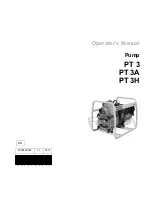
1-800-543-1040
bcs
america
.com
3
1. S
ubmerge the suction hose (with Foot Valve
/ Strainer combination installed) into the
water source to fill suction hose as much
as possible prior to connecting the suction
hose to the inlet port, located near the
center of the pump.
2. Connect the suction hose to the pump
using the cam lock provided and secure
with safety hair pins.
3. Remove the top plug located above the
discharge port outlet and fill with water
until water runs out of the discharge port.
4. Reinstall the top plug. Be sure to tighten to
avoid any air or water leaks.
5. Connect your discharge hose via provided
cam locks and secure this fitting with the
safety hair pins.
Operation of the Pump
1. Place tractor and pump on level ground,
whenever possible.
2. Check that the tractor’s wheel speed selector is
in the neutral position.
3. Raise the throttle lever to full throttle position
after engine has warmed up.
4. Attach suction and discharge hoses; then
prime the pump (see instructions).
5. Engage the PTO.
6. Once pump is primed and water is being
discharged, adjust your engine RPM to proper
speed, according to your pumping application.
7. Using the OPC ring located on the longer
lanyard, secure the red OPC handle on the left
side of the handle bar to keep it engaged while
the pump is in use.
Storage
1. Drain pump. Flush pump after use.
One of the most common causes for faulty
pump performance is gumming or corrosion
inside the pump. Flush the pump and entire
system with a solution that will chemically
neutralize the liquid pumped. Mix according to
the manufacturer’s directions. This will dissolve
most residues remaining in the pump, leaving
the inside of the pump clean and ready for use.
To Prevent Corrosion and Freezing:
After cleaning the pump as directed above,
flush it with permanent-type automotive
antifreeze (Prestone, Zerex, etc.) containing
a rust inhibitor. Use a 50% solution; half
antifreeze and half water, or fill the pump with
FLUID FILM and drain it. A protective coating
of FLUID FILM will remain on the inner pump
surfaces. Save the excess FLUID FILM for the
next application. Plug ports to keep out air
during storage. For short periods of idleness,
noncorrosive liquids may be left in the pump,
BUT AIR MUST BE KEPT OUT. Plug the ports or
seal port connections.
2. Store pump in a clean, dry environment.
OPERATION AND MAINTENANCE
Connecting the Pump to a BCS Tractor
1. Connect the Power Cradle to your tractor
either by attaching it to the two PTO studs
with 12mm conical washers and nuts, or by
utilizing the BCS Quick Hitch (bushing and
tang not included).
2. Mount the pump to the Power Cradle: raise
the red lever on the bushing of the cradle,
insert the male tang of the pump, then
lower the red lever, making sure that the
lever is fully seated.
3. Using the provided spacers, adjust the stem
caster wheel setting so as to position the
pump as level as possible. Secure stem
caster placement with the provided lynch
pin, located on the shorter lanyard and
connected to the pump.
4. Prime pump according to instructions in
next section below.
Priming the Pump
IMPORTANT: PUMP MUST NOT BE RUN DRY
This self-priming pump must be primed prior
to the PTO engagement or damage will occur
to the mechanical seal which depends on the
liquid for its lubrication.


























